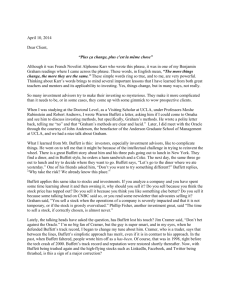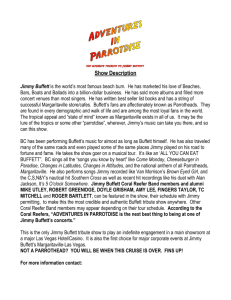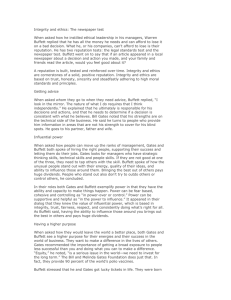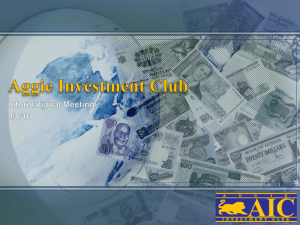WarrenBuffett
advertisement
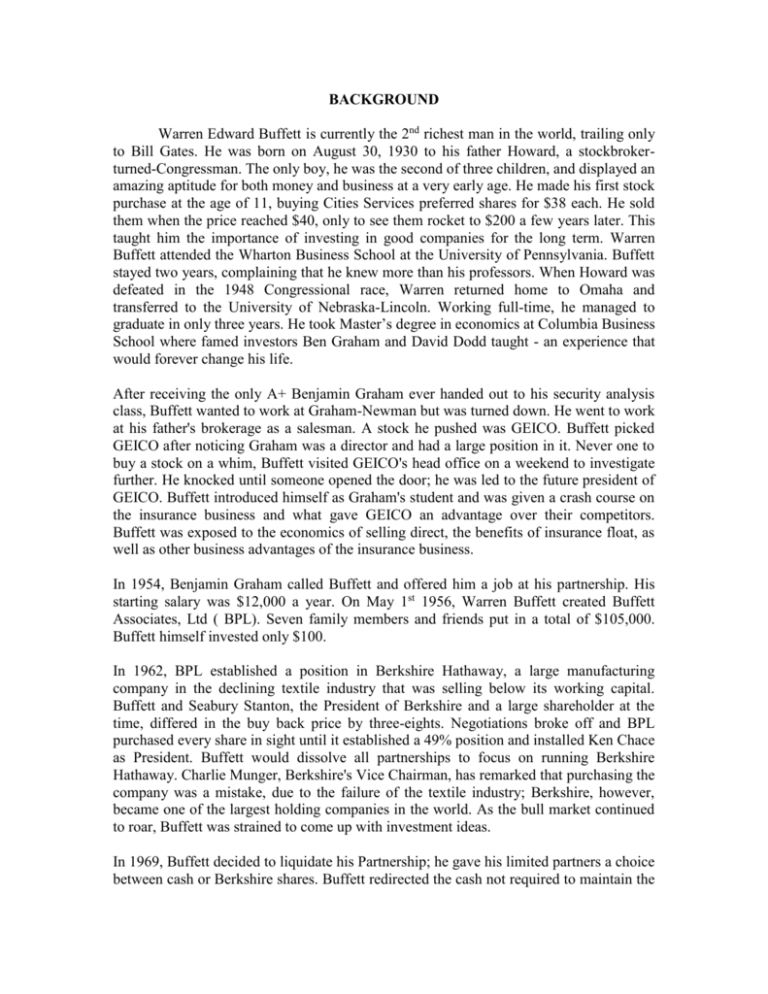
BACKGROUND Warren Edward Buffett is currently the 2nd richest man in the world, trailing only to Bill Gates. He was born on August 30, 1930 to his father Howard, a stockbrokerturned-Congressman. The only boy, he was the second of three children, and displayed an amazing aptitude for both money and business at a very early age. He made his first stock purchase at the age of 11, buying Cities Services preferred shares for $38 each. He sold them when the price reached $40, only to see them rocket to $200 a few years later. This taught him the importance of investing in good companies for the long term. Warren Buffett attended the Wharton Business School at the University of Pennsylvania. Buffett stayed two years, complaining that he knew more than his professors. When Howard was defeated in the 1948 Congressional race, Warren returned home to Omaha and transferred to the University of Nebraska-Lincoln. Working full-time, he managed to graduate in only three years. He took Master’s degree in economics at Columbia Business School where famed investors Ben Graham and David Dodd taught - an experience that would forever change his life. After receiving the only A+ Benjamin Graham ever handed out to his security analysis class, Buffett wanted to work at Graham-Newman but was turned down. He went to work at his father's brokerage as a salesman. A stock he pushed was GEICO. Buffett picked GEICO after noticing Graham was a director and had a large position in it. Never one to buy a stock on a whim, Buffett visited GEICO's head office on a weekend to investigate further. He knocked until someone opened the door; he was led to the future president of GEICO. Buffett introduced himself as Graham's student and was given a crash course on the insurance business and what gave GEICO an advantage over their competitors. Buffett was exposed to the economics of selling direct, the benefits of insurance float, as well as other business advantages of the insurance business. In 1954, Benjamin Graham called Buffett and offered him a job at his partnership. His starting salary was $12,000 a year. On May 1st 1956, Warren Buffett created Buffett Associates, Ltd ( BPL). Seven family members and friends put in a total of $105,000. Buffett himself invested only $100. In 1962, BPL established a position in Berkshire Hathaway, a large manufacturing company in the declining textile industry that was selling below its working capital. Buffett and Seabury Stanton, the President of Berkshire and a large shareholder at the time, differed in the buy back price by three-eights. Negotiations broke off and BPL purchased every share in sight until it established a 49% position and installed Ken Chace as President. Buffett would dissolve all partnerships to focus on running Berkshire Hathaway. Charlie Munger, Berkshire's Vice Chairman, has remarked that purchasing the company was a mistake, due to the failure of the textile industry; Berkshire, however, became one of the largest holding companies in the world. As the bull market continued to roar, Buffett was strained to come up with investment ideas. In 1969, Buffett decided to liquidate his Partnership; he gave his limited partners a choice between cash or Berkshire shares. Buffett redirected the cash not required to maintain the textile business to acquire private businesses and stocks of public companies. At the core of his strategy was to purchase or build insurance or reinsurance companies and use them as super margin accounts to buy equities. Berkshire chooses managers who demonstrated unwavering underwriting discipline and cost consciousness throughout their careers. To align the interest with Berkshire shareholders, insurance managers are compensated for underwriting profit and not for meeting revenue growth targets. In 1970, Warren Buffett owns 29% of the stock outstanding in Berkshire Hathaway. He names himself chairman and began writing the annual letter to shareholders. Berkshire Hathaway made $45,000 from textile operations, and $4.7 million in insurance, banking and investments. In 1973, Stock prices began to drop. At Buffett's direction, Berkshire borrowed money by issuing notes at 8%. Berkshire began to acquire stock in the Washington Post Company. Due to falling stock prices, the value of Berkshire's stock portfolio began to fall. Warren’s personal wealth was cut by more than 50%. The U.S. Securities and Exchange Commission opened a formal investigation into Warren GH Buffett and one of Berkshire's mergers. Nothing ever came of it. By the late '70s, his reputation had grown to the point that the rumor Warren Buffett was buying a stock was enough to shoot its price up 10%. Berkshire Hathaway's stock was trading at more than $290 a share, and Buffett's personal wealth was almost $140 million. The irony was that Warren never sold a single share of his company, meaning his entire available cash was the $50,000 salary he received. Buffett purchases Nebraska Furniture Mart for $60 million and ends the year with $1.3 billion in its corporate stock portfolio. Berkshire begins the year at $775 per share, and ends at $1,310. Warren’s net worth is $620 million in 1983. In 1985, Buffett shuts down the Berkshire textile mills after years of sustaining it. He refuses to allocate additional capital to it. Buffett purchases Scott & Fetzer for around $315 million. It sells products including Kirby vacuums and the World Book Encyclopedia. Warren helps orchestrate the merger between ABC and Cap Cities. He is forced to leave the Board of the Washington Post because federal legislation prohibits him from sitting on the Boards of both Capital Cities and Kay Graham's Washington Post. Berkshire share price reaches $3,000. In the aftermath of the crash of October 1987, Berkshire loses 25% of its value, dropping from $4,230 per share to around $3,170. A year later, in 1988, he started buying up Coca-Cola stock like an addict. His old neighbor, now the President of Coca-Cola, noticed someone was loading up on shares and became concerned. After researching the transactions, he noticed the trades were being placed from the Midwest. He immediately thought of Buffett, whom he called. Warren confessed to being the culprit and requested they don't speak of it until he was legally required to disclose his holdings at the 5% threshold. Within a few months, Berkshire owned 7% of the company, or $1.02 billion dollars worth of the stock. Within three years, Buffett's Coca-Cola stock would be worth more than the entire value of Berkshire when he made the investment. By 1989, Berkshire Hathaway was trading at $8,000 a share. Buffett was now, personally, worth more than $3.8 billion dollars. Within the next ten years, he would be worth ten times that amount. Before that would happen, there were much darker times ahead (read The Solomon Scandal). During the remainder of the 1990's, the stock catapulted as high as $80,000 per share. Even with this astronomical feat, as the dot-com frenzy began to take hold, Warren Buffett was accused of "losing his touch". In 1999, when Berkshire reported a net increase of 0.5% per share, several newspapers ran stories about the demise of the Oracle. Confident that the technology bubble would burst, Warren Buffett continued to do what he did best: allocate capital into great businesses that were selling below intrinsic value. His efforts did not go unrewarded. When the markets finally did come to their senses, Warren Buffett was once again a star. Berkshire's stock recovered to its previous levels after falling to around $45,000 per share, and the man from Omaha was once again seen as an investment icon. In 2002, Buffett entered in $11 billion dollars worth of forward contracts to deliver US dollars against other currencies. By December 31 2003, his gain on the contracts from last year was over $600 million dollars. Buffett also placed second to Ralph Nader in an online web poll, conducted by iswitched.org, of possible candidates for the Green Party nominee for President in 2004. The gains from the 2002 contract were reduced in 2005 when the US dollar strengthened. Valuing a Company Warren Buffet is known to be the ultimate and most original value investor. Value investors look for securities with prices that are unjustifiably low based on their intrinsic worth. Most often intrinsic worth is estimated by analyzing a company's fundamentals. Like bargain hunters, value investors seek products that are beneficial and of high quality but under priced. Since the future is always uncertain, Warren Buffett firmly believes that an investor should leave a margin of safety in investing. He learned this concept at the knee of his mentor, Benjamin Graham, the famed Wall Street investor and Columbia University professor. Graham, who made his fortune during the Great Depression, stressed that unforeseen factors can play havoc with even the best thought-out analysis. So he taught his students to allow plenty of room for hidden problems. According to Graham, smart investors don't buy stocks at fair value — they buy them when the stock is trading well below its fair value. In fact, a very rewarding strategy is to wait for a highly negative environment (like poor monsoons, or global slowdown) and then pick up such stocks. Of course, this implies that one is willing to wait for years, till the business cycle turns again and the valuations of the stock rise again. Buffett expressed a similar notion when he observed that "a great investment opportunity occurs when a marvelous business encounters a one-time huge problem." Early on in his career, he made a fortune by buying American Express shares when they sunk as a result of a corporate scandal involving one of its clients. In the 1970s, he jumped into GEICO shares when the auto insurer ran into temporary financial difficulties. In the late 1980s, he acquired a major block of Coca-Cola shares when the company was still living down a legacy of bad management and the embarrassment of the New Coke fiasco. But just because a company appears cheap doesn't mean that it meets Buffett's stringent requirements. In valuing the company, Warren Buffet uses 6 principal steps that he holds strongly; First Step : ROE ROE reveals the rate at which shareholders are earning income on their shares. Warren Buffett always looks at ROE to see whether or not a company has consistently performed well in comparison to other companies in the same industry. ROE is calculated as follows: Net Income = Shareholder's Equity Looking at the ROE in just the last year isn't enough. The investor should view the ROE from the past five to 10 years to get a good idea of historical performance. Second Step: Debt/Equity ratio The debt/equity ratio is another key characteristic Buffett considers carefully. Buffett prefers to see a small amount of debt so that earnings growth is being generated from shareholders' equity as opposed to borrowed money. The debt/equity ratio is calculated as follows: Total Liabilities = Shareholders' Equity This ratio shows the proportion of equity and debt the company is using to finance its assets and the higher the ratio, the more debt - rather than equity - is financing the company. A high level of debt compared to equity can result in volatile earnings and large interest expenses. For a more stringent test, investors sometimes use only long-term debt instead of total liabilities in the calculation above. Third Step: Profit margins The profitability of a company depends not only on having a good profit margin but also on consistently increasing this profit margin. This margin is calculated by dividing net income by net sales. To get a good indication of historical profit margins, investors should look back at least five years. A high profit margin indicates the company is executing its business well, but increasing margins means management has been extremely efficient and successful at controlling expenses. Fourth Step : Market reputation Buffett typically considers only companies that have been around for at least 10 years. As a result, most of the technology companies that have had their initial public offerings (IPOs) in the past decade wouldn't get on Buffett's radar. Warren buffet assume not to underestimate the value of historical performance, which demonstrates the company's ability (or inability) to increase shareholder value. Fifth Step : Reliability of the products Warren Buffet tends to move away from companies whose products are indistinguishable from those of competitors, and those that rely solely on a commodity such as oil and gas. If the company does not offer anything different than another firm within the same industry, Warren Buffett sees little that sets the company apart. Any characteristic that is hard to replicate is a competitive advantage. The more competitive advantages that a company hold, the harder it gets for the market to compete with the company. Sixth Step : Company value By determining the intrinsic value of a company by analyzing a number of business fundamentals, including earnings, revenues and assets, Warren Buffett will obtain more understanding on the condition of companie’s financial health. A company's intrinsic value is usually higher than its liquidation value - what a company would be worth if it were broken up and sold today. The liquidation value doesn't include intangibles such as the value of a brand name, which is not directly stated on the financial statements. Once Buffett determines the intrinsic value of the company as a whole, he compares it to its current market capitalization - the current total worth (price). If his measurement of intrinsic value is at least 25% higher than the company's market capitalization, Buffett sees the company as one that has value. Besides the six steps, Warren Buffet also includes Management factors to his consideration. 1. Understanding of the market Buffett considers this deep understanding of the operating business to be a prerequisite of a viable forecast of future business performance; i.e. if you don’t understand the business, how can you project performance? 2. Management The first thing that Warren Buffett will ask "Is the management rational?" . Specifically, is management wise when it comes to the question of re-investing earnings or returning profits to shareholders as dividends. Warren Buffet needs to know what is the ultimate goal. Most of the time Agency problem would arise from 90% of common companies. What Warren Buffett's approaches mean that is he largely immune to Wall Street's trend. He doesn't listen to analysts or the press. Nor does he put much faith in management's projections of what a company might earn five or 10 years down the road. He prefers to look at what a company has done in the past and uses that as a guide to the future. The most important think for Warren Buffet is that you have to believe on what your own analysis. Problems in technology stocks The first reason and the most popular reason that Warren Buffett doesn’t invest in technology stock is because the complexity of the industry. Warren buffet hold a belief to invest only in businesses that he can understand. And since he claims that he doesn't understand technology, he stays away from it. Warren Buffet also said that even if technology companies offered the long-term certainty, he still would not invest in them. He explained why at the 1998 annual meeting: "I don't want to play in a game where the other guy has an advantage. I could spend all my time thinking about technology for the next year and still not be the 100th, 1,000th or even the 10,000th smartest guy in the country in analyzing those businesses. In effect, that's a 7- or 8-foot bar that I can't clear. There are people who can, but I can't. The fact that there'll be a lot of money made by somebody doesn't bother me really. There's going to be a lot of money made by somebody in cocoa beans. But I don't know anything about 'em. There are a whole lot of areas I don't know anything about. So more power to 'em. I think it would be a very valid criticism if it were possible that Charlie and I, by spending a year working on it, could become well enough informed so that our judgment would be better than other people's. But that wouldn't happen. And no matter how hard I might train, I still couldn't. Therefore, it's better for us to swing at pitches. Different people understand different businesses. The important thing is to know which ones you do understand and when you're operating within your circle of competence." ( Berkshire Hathaway Annual Shareholders Meeting 1998 , Warren Buffet Opening speech, Pg 3 al 547, http//www.berkshirehathaway.com/meet01/1998meet) Warren Buffett noted that investors had been hypnotized by the staggering ascent of technology stocks and ignored everything else, including whether the businesses they were investing was in fact making money. Warren Buffet was referring to the business model that many dotcoms employed. The purpose of these dotcom businesses is to enrich investors through rising share prices rather than profits. Another point that Warren Buffet addressed is that most of the technology companies have no actual asset in their companies; hence the stability of the company itself is relying on the unforeseen forecast of the business. Warren Buffet insists that any company he buys must be able to capitalize on inflation. Which mean that, if anything goes wrong in the future, the company would still be able to survive in the industry. The technology industry is always changing, the industry is constantly evolving and with low market barrier, there are an increasing numbers of new companies at every moment in time. In order for companies to survive, they have to introduce low cost saving production and efficient production system that are better than their competitor. This fact does not stay with Warren Buffet. He wants to buy companies that can regularly increase the price of the product they sell without losing market share. As technology gets cheaper, profit margins become tougher to maintain. Another question that probably arise is that, why doesn’t he hire someone to analyze the industry?? Warren Buffett answered this in the 1999 Berkshire Hathaway Annual Shareholders meeting. "We will never turn our money over to somebody else. If we're going to lose your money as Berkshire shareholders, we're going to lose it ourselves -- and we're going to come back and look you in the eye and tell you how we lost it. We are not going to say this game is too tough -- so we'll give our money to somebody else. You don't need the intermediaries of Charlie and me to do it for you." (1999 Berkshire Hathaway Annual Shareholders Meeting, Warren Buffet Shareholders question Speech, http://www.berkshirehathaway.com/1999meeting). Warren Buffet momentum While abandoning technology stocks, Berkhire Hathaway has managed to beat the market index. . Over the past five years, shareholders in Buffett's company have seen the value of their shares soar by 60% while the stock market has crashed around them. Conclusion According to the Gibbs inequality, in a vast changing environment, prediction made by novice investor will outperform the expert’s prediction. This is one of the reason why in technology industries, new companies are usually the one that succeed. So why does Warren Buffett refuse to participate in the internet boom era?? The answer is conservatism. Warren Buffett believes that he does not understand the industry; as a result he believes that is not worthy to invest in it. Hence the value in the technology stock has been decreased. The information value is not valuable anymore because there is a noise that distracting the receiver from receiving the full value. For our personal experience from doing the case, the most amazing aspect of this whole story, is the enormous amount of self-discipline that Buffet has displayed. When tech stocks were multiplying every few months, it must have been extremely difficult to stay away. All of us know this from our own experiences. However, Buffet and other famous investors have always stressed this as one of the key attributes for successful investing the ability to stick to one's convictions even when the rest of the world believes something else. REFERENCES Chen, J. 2005. The Physical Foundations of Economics : An Analytical Thermodynamic Theory. World Scientific, Singapore. www.yahoo.com/finance www.Berkshirehathaway.com/ 1998meeting www.Berkshirehathaway.com/1999meeting http://www.moneysense.ca/investing/stocks_markets/article.jsp?content=20030103_1634 25_4876 http://www.rediff.com/money/2004/mar/18guest.htm http://www.cnn.com/2005/US/05/10/buffett/ http://www.platinum.com.au/reports/arch/buffett.pdf http://www.wikipedia.com/Warren buffet bio THE ORACLE of OMAHA and Technology Stocks COM 421 Portfolio Theory and Management Jing Chen Students : Ryan Darmasubrata Yizhen, Yin 230055322 230060233

